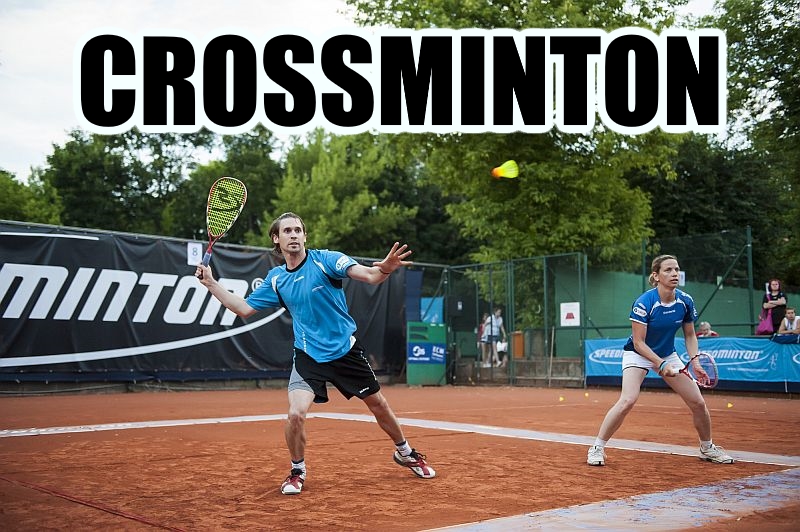En nog meer ....
/
De sport Crossminton

Crossminton is een jonge sport en laat zich omschrijven als een combinatie van tennis, badminton en squash.
Zowel in het materiaal, de techniek en het wedstrijdveld zijn elementen van deze drie bekende sporten terug te vinden.
Het racket is het beste aan te duiden als een mini-squash racket en een wedstrijd wordt gespeeld op een halve tennisbaan. De twee speelhelften liggen 12,8m uit elkaar en er is geen net.
De speeder (mini shuttle) is kleiner en zwaarder dan een traditionele badminton shuttle waardoor de grote afstand te overbruggen is en er snelle slagenwisselingen ontstaan. De sport is zowel indoor als outdoor te beoefenen.
Door deze unieke eigenschappen heeft de sport veel potentie en is heel toegankelijk voor jong en oud.
Crossminton staat in Nederland in de kinderschoenen. Een aantal groepen spelers zijn verspreid over het land actief en de bond Crossminton Nederland organiseert geregeld toernooien.
In tegenstelling tot Nederland is de sport in veel andere landen veel verder ontwikkeld. In Europa zijn in met name Duitsland, Frankrijk en de oosteuropese landen competities opgezet en worden veel toernooien georganiserd. Ook in Azië is de sport sterk aan het groeien.
Wereldwijd wordt de crossmintonsport in meer dan 30 landen beoefend. Onder auspiciën van de Internationale Crossminton Organisatie (ICO) zijn sinds het ontstaan van de sport in 2003 al 8 WK’s en EK’s georganiseerd.
Bekijk hier de after-movie van het WK2025
Crossminton vs Speedminton®
De sport Crossminton is ontstaan uit het recreatieve spel dat met Speedminton® gespeeld kan worden. In 2000 is Speedminton® op de markt gekomen en in 2003 is in Berlijn de Internationale Crossminton Organisatie (ICO) opgericht om de sport crossminton te ontwikkelen.
Sindsdien is Speedminton® hoofdsponsor van alle internationale bonden en vele (inter) nationale toernooien.
Nederland.. verenigingen gezocht!
Heb jij interesse in een nieuwe uitdagende sport en/of wil jouw vereniging aan hun leden een extra sport aanbieden dat zeer toegankelijk is en goedkoop is om te implementeren? Wij staan in nauw contact met de bond en kunnen u helpen met het bespreken van de mogelijkheden.
Wij horen graag van u telefonisch of via het contact formulier.
SPELREGELS
Crossminton wordt gespeeld volgens de spelregels die door de International Crossminton Organisation (ICO) zijn opgesteld. Hieronder vind je in het Engels een korte samenvatting van de spelregels. Ook kan je de officiele spelregels downloaden via de website van de ICO.
The game
A game ends when one player reaches 16 points. If the score is tied at 15 or greater, play continues until one player has a two-point advantage. A match consists of three wins (best of five).

Service
The players draw to decide which player serves first. Service then alternates after every three serves. Every serve counts. If the score is tied at 15:15, service alternates after each point. The serve has to be from the service zone. You let the Speeder™ drop from hip level and hit it as it falls. The losing side always has first service in the next game.

Scoring
Every volley counts unless it has to be repeated. Points are awarded in the following cases:
- Service fault
- Speeder™ contact with the ground
- Speeder™ lands in playing field (or on one of the lines) and cannot be returned
- Speeder™ lands “out”
- Speeder™ is hit twice by the same player
- Body contact with the Speeder™
- If a player returns an “out” Speeder™, it counts as “accepted” and play continues.

Changing sides
Players change sides after each game to ensure equal playing conditions (wind and lighting conditions). If a fifth game (tiebreak) becomes necessary, players change sides every 6 played points.

Doubles
The Doubles Match (Team A, Team B) is played as described below:
The two double team players are standing in one single court. Each double team consists of a attack and a back space player. The back space player is not allowed to position his rear foot in front of his team mate’s rear foot in the moment of hitting. This action counts as a foul and causes a point loss. The back and front positions of the team players are changing with the service changes, that means the service player is automatically in the back space position (check the service rules as described below). Counting and changeover are equal to the Single Match rules.
Double service
Drawing the lot decides which team plays the first serve. The Service Player has 3 serves in a row (cf. single rules). The service player is the back space player. The non-service team player is the attack player. The services are switching from Player A1 to Player B1 to Player A2 to Player B2. After all 4 double match players made their serves the first serve player starts again. The first serve in the next set gains the team which lost the previous set.
Official tournament rules
The official tournament rules of the International Crossminton Organisation (ICO) can be found here.
Wedstrijd impressie





